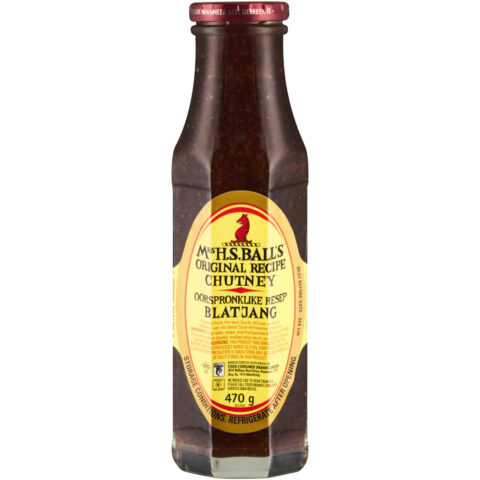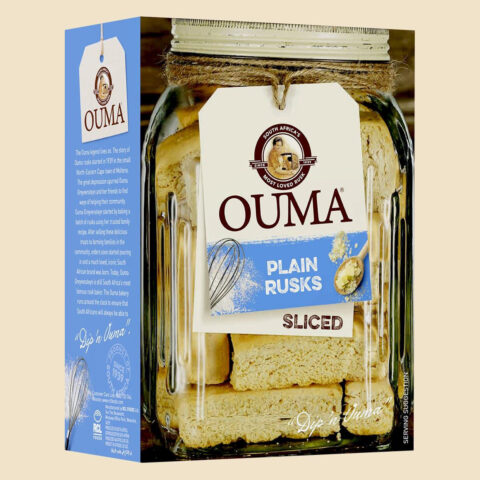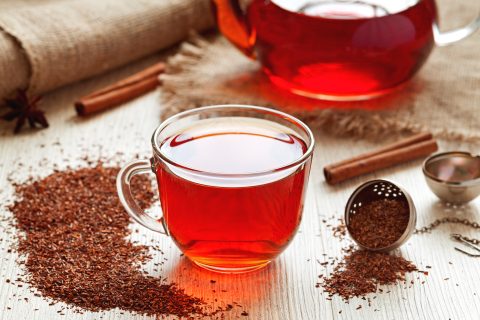Made in SA
Icons Of South Africa
Everyone’s favourite Mrs
It’s mostly sugar, water and vinegar, but the tangy tartness from the dried peaches and apricots and a hint of spice from the chillies give it that edge. Rich fruity flavour aside, what’s said to have cemented the iconic status of Mrs H.S. Ball’s Chutney is the unique eight-sided glass bottle and that oval label with its old-school design, including the Ball family crest at the top. Those features were chosen by a Bree Street businessman named Fred Metter, who financed the Ball’s chutney factory in Retreat in 1917 when local demand for the condiment presaged its uptake internationally. Mrs Ball was born Amelia Adkins. She arrived in South Africa from Canada and used a small gas stove to cook her chutney, which she initially sold at church bazaars. The initials “H.S.” belonged to her husband, Herbert Saddleton Ball. Thanks to Metter’s business savvy, the condiment became a South African pantry staple and, a century later, not only remains a favourite, but is also sold worldwide in a variety of flavours, including original, peach, jalapeño, chakalaka, hot and extra hot.

Take a dip with ouma nonnie
Aside from being one of the coldest places in the country, Molteno in the Eastern Cape is perhaps most famous as the birthplace of Ouma Rusks. Initially marketed under the name “Uitspan”, they were first sold in 1939 when, in the face of the Great Depression, a local church pastor gave a half-crown to each woman in his congregation to kickstart some sort of small business. Elizabeth Ann Greyvensteyn – aka “Ouma Nonnie” – bought ingredients to make traditional buttermilk rusks. They were such a hit that orders began pouring in. A year later, her home industry received a start-up loan from the fledgling Industrial Development Corporation – she used the £1 500 to buy a double-decker oven, expanding her output while her son Leon took bakkie loads of rusks to sell in big cities. Fortuitously, in the 1950s, Leon met Herman Lay, founder of Lay’s potato chips, which led to the creation of the Simba “Chippie”, which, thanks to its iconic lion mascot-style logo, also became ingrained in South African snack culture and is – like Ouma Rusks – still one of the country’s most recognisable household brands.

A tipple endorsed by elephants
An oval-shaped fruit the size of a small plum that ripens to a rich yellow, the marula is produced by the Sclerocarya birrea, or “Elephant Tree”. It gets its nickname because pachyderms love the fibrous, white fruit that tends to ferment quickly. No doubt inspired by tales of elephants getting hammered on the boozy fruit, local entrepreneurs in the early 1980s distilled a clear spirit from marula and, in 1989, after successfully adding cream to the recipe, launched Amarula, a creamy liqueur.
By 1994, they’d taken it abroad, first to Brazil and subsequently to the rest of the world. Locally, it’s become associated with safari sunsets or as a comforting addition to coffees served on dawn game drives, cementing its associations with the continent among foreign visitors. And, crucially, it makes a handy take-home souvenir available at airport duty-free shops.
In 2014, to mark its 25th anniversary, Amarula Gold was launched, and two years later came the tapered “Jabulani” bottle (named for an orphaned baby elephant reintroduced into the wild). In 2018, with an infusion of Madagascan vanilla extract and Nigerian ginger, Amarula introduced its first flavoured cream liqueur, Vanilla Spice. That was followed, in 2019, by Raspberry, White Chocolate and African Baobab, and then Ethiopian Coffee. The range continued to grow with the introduction of Amarula African Gin in 2023.

The peri-peri chicken empire that grew wings
In Rosettenville, 1987, Fernando Duarte took his friend Robbie Brozin to taste the peri-peri chicken at a takeaway joint called Chickenland. The flavour had found its way across the border from Mozambique and was sufficiently mouthwatering to convince the friends to make an offer on the restaurant. They paid R80 000 and renamed it Nando’s, after Fernando’s son. By 1989, they had grown their tiny enterprise into three Joburg outlets and had a branch in Portugal. By 1992, the chain had been acquired by an international investment firm. However, as a company and a brand, Nando’s stuck to its principles of innovating and having fun while conducting business in an ethical and socially responsible manner. Today, Nando’s has over 1 200 branches in some 30 countries and, in the United Kingdom, it’s been named the best large company to work for. Aside from its tongue-in-cheek advertising campaigns that tap into prevailing hot-topic issues, Nando’s has funded an art foundation and design initiative and has pledged to be carbon neutral by 2030. Then there’s its job creation programme, Harambee, which in South Africa is centred on giving unemployed youth an opportunity to move up in the world. All this, and the brand stands by its promise to use only fresh, never frozen, chicken, which they marinate in peri-peri for 24 hours to produce an incomparably succulent and spicy eating experience.
Xhosa knitwear that conquered the world
Laduma Ngxokolo, whose MaXhosa Africa knitwear brand has reached the apex of the African luxury fashion market, first caught national attention in 2016 when he won the coveted Most Beautiful Object in South Africa award for a black and white shawl. The following year, New York’s Museum of Modern Art commissioned him to design a one-of-a-kind jersey for an exhibition of influential fashion, and his garments have famously been worn by the likes of Beyoncé and Alicia Keys.

If you’re a South African with money, good taste and pride in national culture, you really should have at least one Maxhosa garment in your wardrobe; today, there are rugs, cushion covers and other homeware items, too. You can shop the handwoven, locally made range in New York, where the brand has a standalone store, a real coup for African clothing. Ngxokolo’s designs were initially inspired by the patterning and motifs found in Xhosa beadwork; that sensibility, he says, was inherited directly from his mother, who taught him to use a knitting machine when he was growing up.
Today the MaXhosa effect is huge. “People look to us to represent the continent, to be the new voice for African image setting,” says Ngxokolo. “We made a promise to the public to sell them premium products that capture our DNA as South Africans and Africans, and so most of my time is spent on delivering on that promise. The intention is that the love of culture and heritage is in the DNA of each and every line, each collection, each product. Some of our customers are so in love with the brand they leave notes saying they want to be buried in our garments.”





